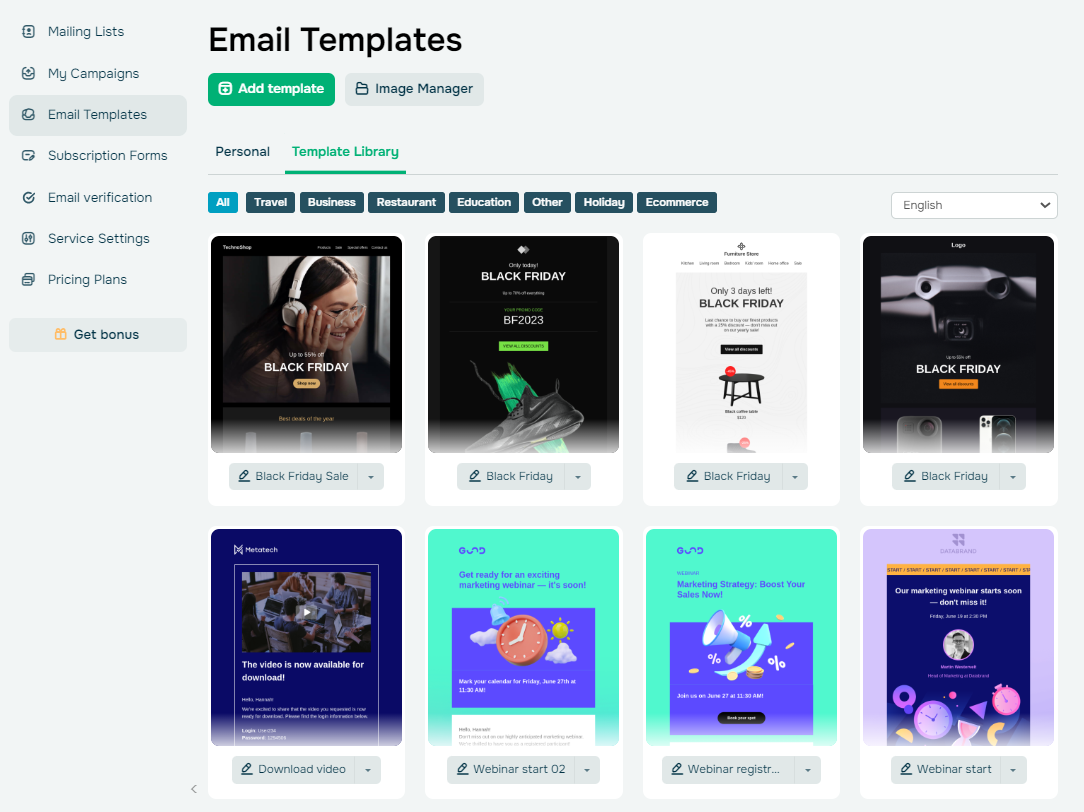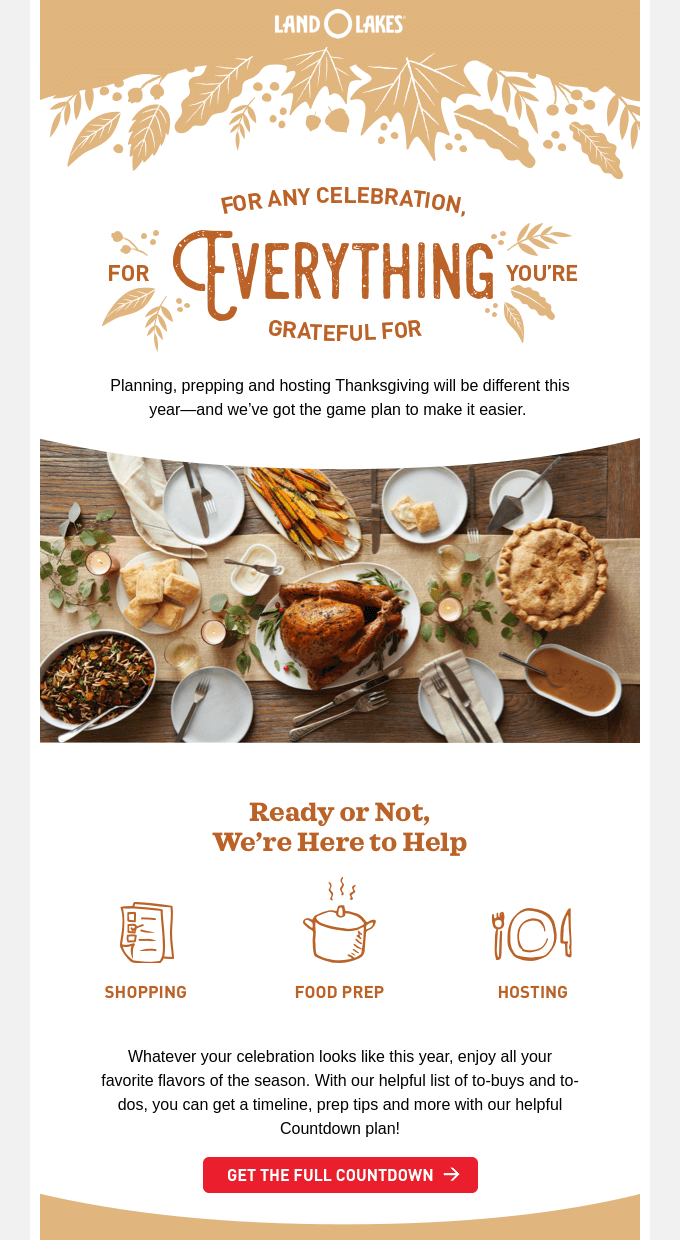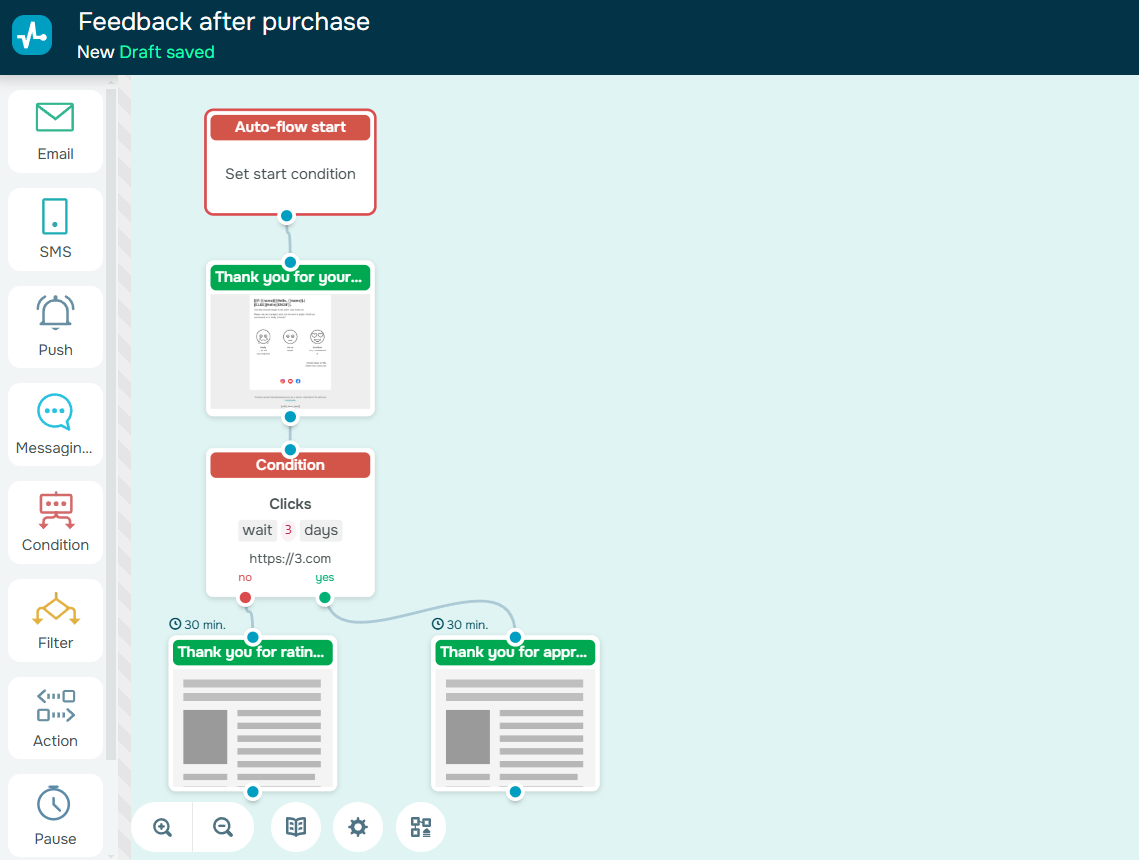Remember when marketing meant printing stacks of flyers, stuffing them into mailboxes, and hoping they wouldn’t end up as makeshift coasters? Thankfully, those days are behind us. Marketing has evolved, and email marketing is leading the way.
Email marketing is like having a personalized, data-driven assistant that works around the clock. Instead of one-size-fits-all messaging, you can now deliver targeted, relevant content straight to your audience’s inbox, right when they need it. No paper wasted, no flyers ignored — just smarter, more effective communication.
In this post, we’ll break down the benefits of email marketing and how it can help businesses of all types and sizes boost engagement, drive sales, and build lasting customer relationships.
Email marketing benefit #1. User preference
With the rise of social media, you might assume email marketing has lost its relevance. But despite repeated predictions of its inevitable decline, email remains a powerful marketing tool to this day.
In 2024, over 251 million emails were sent every minute and 69% of marketers rely on email newsletters to share their content. While social media serves various purposes, from personal communication to business promotion, email has become a business-first channel. Consumers are now used to the fact that nearly every online company offers to subscribe to email newsletters with useful updates or exciting offers.
According to January 2022 data, email remains a key communication channel across all generations in the U.S.:
- Gen Z (ages 9-24): 94% use email regularly
- Millennials (ages 25-40): 98% rely on email for communication
- Gen X (ages 41-56): 98% actively use email
- Boomers (ages 57-75): 95% engage with emails
- Silent generation (ages 76-93): 90% continue to use email
Email marketing benefit #2. Cost-effectiveness
One of the biggest advantages of email marketing is its affordability. Unlike traditional advertising, email marketing doesn’t require a massive budget, making it accessible for businesses of all sizes, including startups and small businesses.
Many email service providers and marketing platforms offer free plans, which are perfect for beginners who want to test email marketing or don’t yet have a large subscriber base. For example, with SendPulse, you can send up to 15,000 emails per month for free. Additionally, most platforms come with user-friendly email builders that require little to no technical knowledge. If any difficulties arise, customer support is usually available to help.
This means you don’t need a dedicated team to start your email marketing campaigns. A single marketer can manage everything in the early stages. If the platform offers pre-designed templates, you can make quick customizations and launch campaigns without hiring a designer.
 In SendPulse, you can choose an email template from the library
In SendPulse, you can choose an email template from the library
In 2023, the global email marketing market was valued at $8.3 billion, with projections indicating growth to $18.9 billion by 2028. During this period, the market is expected to expand at a compound annual growth rate of 18.8%. This rapid expansion proves that email isn’t just budget-friendly, it’s a high-performing marketing channel that drives real revenue.
Email marketing benefit #3. Higher sales
One of the biggest email marketing benefits is its ability to drive sales, whether for a single product, a full collection, or even an entire brand. How exactly do emails influence the number of orders? In two ways: directly, by promoting products and services with links that lead customers straight to your website, and indirectly, by building trust with potential customers and gradually guiding them toward a purchase.
Let’s look at the direct approach in action. A company launches a holiday promotion — let’s say, for Christmas. While the offer is available on the website, it will only reach visitors who actively check for updates. However, if a marketer sends an email campaign announcing a special Christmas deal, some subscribers will click through to the website, explore the offer, and make a purchase.
For businesses looking to take their email marketing campaigns further, modern technology like AMP (Accelerated Mobile Pages) for email offers even greater potential. AMP enables interactive elements, such as in-email checkout options, so customers can complete their purchase without ever leaving their inbox.
Email marketing benefit #4. Lead nurturing
Let’s consider another approach. Not every email needs to push a sale. Sometimes, providing value is the key to winning customers.
Let’s say a company creates an email with a holiday preparation checklist and gift ideas related to its business. The goal isn’t to sell but to offer helpful content. Some recipients will appreciate the effort, enjoy the recommendations, and remember the brand when they’re ready to buy.
 Land O’Lakes created an email with a Thanksgiving preparation plan; source: Really Good Emails
Land O’Lakes created an email with a Thanksgiving preparation plan; source: Really Good Emails
This highlights a core email marketing advantage — it helps nurture relationships with potential customers over time. Just because someone joins your mailing list doesn’t mean they’re ready to buy. With strategic email marketing campaigns, businesses can guide leads through the customer journey, building trust and increasing conversion rates.
A great starting point is a welcome email series, where companies typically introduce themselves and provide value to new subscribers. For example, a SaaS company can use this type of email to highlight key platform features, share customer support contacts, and link to a knowledge base.
eCommerce companies often use this opportunity to briefly explain their brand concept, shopping policies, or even offer a first-purchase discount to encourage sales.
The impact of email marketing benefits in lead nurturing is undeniable — 27% of consumers said that receiving a brand’s regular newsletter made them likely or very likely to make a purchase.
Email marketing benefit #5. Measurable results
Another advantage of email marketing for businesses is the ability to track clear, measurable results. There are essential metrics that indicate the success of your email campaigns. By analyzing these metrics, you can determine whether to stick with your current strategy or experiment with new ideas and approaches.
Here’s what marketers focus on when working with email campaigns:
- click-through rate tracks how many recipients click on the links within the email, helping you understand engagement levels;
- conversion rate measures the percentage of recipients who take a target action, like making a purchase;
- bounce rate indicates the number of undelivered emails, helping marketers maintain mailing list health;
- unsubscribe rate reveals how many recipients unsubscribed, indicating the relevance of your content;
- revenue per email measures how much revenue was generated for each email sent, which directly correlates with your email’s effectiveness in generating sales;
- open rate, though not as reliable due to privacy changes like Apple’s Mail Privacy Protection, still provides an overview of initial engagement with your subject lines.
Email marketing benefit #6. 24/7 availability
Customers expect businesses to be available when they need them, even outside regular working hours. One of the key advantages of email marketing automation is that it ensures businesses can respond instantly, no matter the time of day.
With email automation, you can set up triggered emails that are sent in response to specific customer actions. Take registration, for instance. When a user fills out a sign-up form on your website, they automatically receive a welcome email confirming their registration and providing details on how to get started with your platform.
Another example is lead magnets. If a user comes across your offer, such as a free guide in exchange for their email address, a triggered email campaign ensures they receive the promised guide directly in their inbox.
 The Lifeforce email includes a lead magnet to thank users for their subscription; source: Really Good Emails
The Lifeforce email includes a lead magnet to thank users for their subscription; source: Really Good Emails
The flexibility of email marketing goes beyond business hours — it also extends across time zones, showcasing the benefits of email marketing automation. This is especially crucial for businesses catering to international audiences.
For instance, imagine you’re launching a new product collection and want your email campaign to reach subscribers at 9:00 AM local time. If your list includes users from both Australia and the U.S., a poorly scheduled email might land at 9:00 AM for Australians but 5:00 AM for Americans, making it far less effective.
To avoid this, choose an email service provider with advanced scheduling features, like SendPulse. By segmenting your subscribers by location, you can ensure emails arrive at the most optimal time, increasing engagement and reducing the risk of unsubscribes due to poorly timed messages.
 In SendPulse, you can select the desired time and time zone for your email campaign
In SendPulse, you can select the desired time and time zone for your email campaign
Email marketing benefit #7. Additional traffic
In 2023, marketing emails in the financial services sector had the highest click-to-open rate at 15.4%, followed by the publishing industry at 14.43% and the communications sector at 13.29%.
What does this mean in real numbers? Imagine 5,000 users open your email. If your company operates in financial services, an average 15.4% click-to-open rate means around 770 recipients will likely click on a link within the email. That’s 770 potential customers landing on your website, without any additional ad spend. While not all will convert, every click is an opportunity to nurture leads and increase sales.
This is one of the biggest benefits of email marketing campaigns — they don’t just boost engagement; they drive real traffic to any page on your website. Whether you’re launching a sale, introducing a new collection, or announcing a contest, and fuel business growth.
Email marketing benefit #8. Saved time
We have already touched on email automation and how it enables businesses to engage with customers 24/7. Beyond that, automation also helps save time for your marketing team — or for you, if you’re managing email marketing yourself.
Email automation platforms allow you to set up entire email flows that adjust based on user actions or inaction. For instance, SendPulse offers a library of ready-made automation templates that you can customize for your business. One popular example is the “Feedback after purchase” flow. Here’s how it works:
 The “Feedback after purchase” flow in the SendPulse builder
The “Feedback after purchase” flow in the SendPulse builder
If a customer makes a purchase, the system triggers an automated flow after a set period. The customer then receives a thank-you email requesting feedback. After a set period (e.g., three days), the system checks if the user has left a review. Based on their response, they receive a personalized follow-up email.
Beyond ready-made templates, email marketing automation platforms also offer drag-and-drop builders for fully customized workflows. Marketers only need to design, set up, and test the flow once, after that, the system runs automatically. This allows marketers to focus on more creative or strategic tasks while ensuring that users receive relevant emails tailored to their needs and behavior.
Email marketing benefit #9. Relevant and personalized content
Personalization makes emails more engaging, and more effective. Personalized emails receive a 41% higher click rate, and 80% of customers are more likely to buy from brands that provide personalized experiences.
So, how can businesses personalize their emails? It depends on the data they collect. Personalization can range from simple techniques, like using a subscriber’s name, to advanced strategies, such as tailoring recommendations based on past purchases and browsing behavior.
One of the most common yet extremely effective approaches is adding the subscriber’s name in the subject line or email body. It makes messages feel much more direct and engaging.
Another basic way is language personalization. If your audience speaks multiple languages, send emails in the language they prefer. For example, if a Canadian company, focused on the domestic market, collects subscribers via a subscription form on their website, they could add an option, “What language would you like to receive newsletters in?” with options like English and French. This data is then stored in their profile, enabling segmented email campaigns based on language preference.
Businesses can also tailor emails based on purchase history, browsing behavior, and user preferences. Imagine you run an online fashion store selling both men’s and women’s clothing. Instead of sending a generic message, you can make your “New Arrivals” email more effective by tailoring it to the subscriber’s interests, for instance:
- If a customer has previously purchased luxury brand items, the email can feature new arrivals from premium brands.
- If they frequently browse men’s sneakers, the email can highlight new sneaker releases.
The more customer data a business collects, the more refined and targeted email content can become. This requires a robust CRM system to store and manage subscriber information, track behaviors, and automate segmentation. SendPulse CRM helps businesses streamline customer relationships by tracking leads, segmenting contacts based on specific criteria, and monitoring interactions. Its key features include detailed customer profiles and real-time analytics, allowing businesses to tailor their email campaigns for maximum engagement and conversions.
In the following example, FashionNova sends personalized product recommendation emails when a subscriber searches for an item, like a “little black dress,” but doesn’t complete a purchase.
This email falls under the category of triggered emails. When a potential customer browses a product but leaves without buying, the email marketing platform automatically triggers a follow-up email. Since every subscriber’s browsing behavior is unique, each triggered email is dynamically tailored to their interests, increasing the chances of conversion.
People are glued to their phones, whether they’re shopping, working, or just scrolling for entertainment. In fact, nearly 46% of all emails are opened on mobile devices, which means if your emails aren’t mobile-friendly, you could be losing half your audience before they even read your message.
That’s why email is such a powerful multiplatform tool, as it works seamlessly across desktops, tablets, and smartphones. Most email marketing platforms now include drag-and-drop builders that automatically optimize emails for any screen size. Even better, some platforms let you preview your email before sending it out.
For example, SendPulse offers a real-time preview feature, so you can check exactly how your email looks on mobile and desktop. This helps ensure your content is clear, engaging, and easy to read, no matter what device your audience is using.
 In SendPulse builder, you can check how the email looks on a mobile device
In SendPulse builder, you can check how the email looks on a mobile device
Email marketing benefit #11. Full control over the content recipients see
With social media, you don’t have full control over what users see, since algorithms decide which posts to show them. On the other hand, email marketing benefits businesses by giving them full control over their messaging, allowing them to deliver targeted campaigns at the right moment.
Here’s how email marketing campaigns can be used effectively at each stage of the customer journey.
At the awareness stage, users have just discovered your brand, so the goal is to provide value and introduce them to what you offer:
- welcome emails — introduce your brand and set expectations for future communication;
- educational content emails — share blog posts, industry insights, or helpful guides to position your business as a trusted resource.
At the consideration stage, customers are evaluating your offerings and comparing them with competitors. Use this stage to highlight your unique value:
- product or service overviews — explain key features, benefits, or success stories;
- testimonials and case studies — showcase real customer experiences;
- comparison emails — demonstrate what sets your business apart from competitors;
- webinar invitations — offer in-depth insights into your product or industry trends.
Now, the customer is ready to make a decision, but they may still have last-minute hesitations. These emails can nudge them toward making a purchase.:
After a purchase, comes the retention stage and the focus shifts to building loyalty and encouraging repeat purchases:
- order confirmation and shipping updates — keep customers informed about their purchase;
- feedback requests — ask for reviews and testimonials to improve trust and engagement;
- loyalty program invitations — reward repeat customers with exclusive perks.
Happy customers can become your best marketers. At the advocacy stage, you need to encourage them to spread the word:
- referral program emails — offer rewards for referring friends;
- exclusive access emails — provide VIP offers or early access to new products;
- user-generated content requests — ask customers to share their experiences on social media;
- surveys and engagement emails — keep the conversation going and collect valuable feedback.
Email marketing benefit #12. Scalability
The benefits of email marketing for small businesses are just as significant as those for larger businesses. Companies of all sizes can gather subscriber contacts using different strategies tailored to their resources and audience reach.
For small businesses, growing an email list often relies on organic strategies that don’t require a large budget:
- website sign-up forms — add embedded forms or pop-ups on landing pages to collect emails;
- lead magnets — offer freebies like eBooks, discount codes, or exclusive content in exchange for email subscriptions;
- social media promotions — encourage followers to subscribe through contests, gated content, or special offers;
- networking and events — collect emails at trade shows, webinars, or in-store visits.
Larger companies usually have more resources and existing customer bases to scale mailing list growth:
- eCommerce checkout process — prompt customers to subscribe during purchases;
- loyalty programs — encourage sign-ups by offering exclusive perks to members;
- paid ads and retargeting — run lead generation campaigns on platforms like Facebook, Google, or LinkedIn to attract new subscribers.
Email marketing benefit #13. Compliance and security
Email marketing follows clear rules that protect both businesses and subscribers, which are some of the key pros of email marketing. Laws like GDPR, CAN-SPAM, and CCPA require companies to get permission before sending emails, offer easy unsubscribe options, and handle customer data responsibly. This makes email marketing a controlled and compliant way to engage with your audience while protecting their privacy.
Following these regulations isn’t just about avoiding fines. It helps businesses build trust and credibility. Unlike social media, where changing algorithms affect who sees your content, email marketing ensures your messages reach subscribers directly and securely.
Email marketing benefit #14. Gathering feedback
Email marketing is not a one-way channel, and it’s one of the powerful email marketing advantages. Subscribers can also interact with you, making it a valuable tool for collecting feedback. Since they have willingly shared their email address with you, they are already open to communication. Plus, they receive your emails and are familiar with your brand, making email the perfect channel to ask for their opinion on your products or services.
What’s even better is that you can gather feedback not only from existing customers but also from those who haven’t made a purchase yet. Ask them what kind of content they’d like to receive, what information they need to make a decision, or what’s missing from your emails. AMP technology allows subscribers to interact with content directly within the email. This can include filling out forms or responding to surveys.
In addition to feedback from potential and existing customers, you can also ask subscribers for personal data about their preferences. This will help the company create more personalized email campaigns and product offers. This is exactly what Grind did. Of course, to motivate the user to spend their time, you need to explain why you need this data, and it’s even better to offer a bonus.
Conclusion
Email marketing is a reliable tool that hasn’t faded over time — instead, it has only improved. It works just as well for businesses with a small subscriber base as it does for those scaling up. No matter what goal you set, email can be a key part of your strategy. The same applies to all stages of the customer journey. And the advantages of using email marketing we’ve discussed confirm this.
To make email your go-to channel, choose the right platform. Try SendPulse to create, automate, and optimize your campaigns with ease. You can test our tools with the Free plan — send up to 15,000 emails per month at no cost.